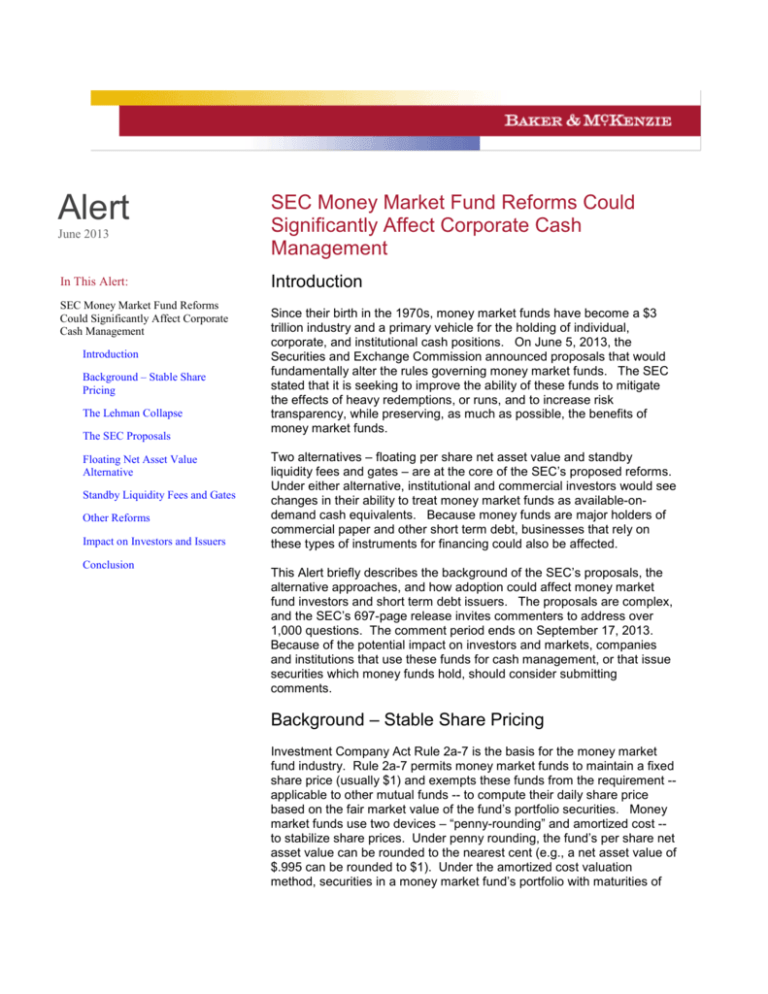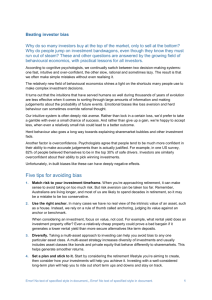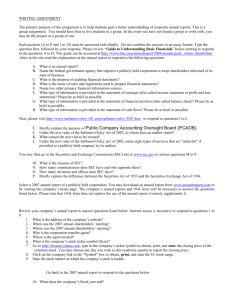
Alert
SEC Money Market Fund Reforms Could
Significantly Affect Corporate Cash
Management
In This Alert:
Introduction
June 2013
SEC Money Market Fund Reforms
Could Significantly Affect Corporate
Cash Management
Introduction
Background – Stable Share
Pricing
The Lehman Collapse
The SEC Proposals
Floating Net Asset Value
Alternative
Standby Liquidity Fees and Gates
Other Reforms
Impact on Investors and Issuers
Conclusion
Since their birth in the 1970s, money market funds have become a $3
trillion industry and a primary vehicle for the holding of individual,
corporate, and institutional cash positions. On June 5, 2013, the
Securities and Exchange Commission announced proposals that would
fundamentally alter the rules governing money market funds. The SEC
stated that it is seeking to improve the ability of these funds to mitigate
the effects of heavy redemptions, or runs, and to increase risk
transparency, while preserving, as much as possible, the benefits of
money market funds.
Two alternatives – floating per share net asset value and standby
liquidity fees and gates – are at the core of the SEC’s proposed reforms.
Under either alternative, institutional and commercial investors would see
changes in their ability to treat money market funds as available-ondemand cash equivalents. Because money funds are major holders of
commercial paper and other short term debt, businesses that rely on
these types of instruments for financing could also be affected.
This Alert briefly describes the background of the SEC’s proposals, the
alternative approaches, and how adoption could affect money market
fund investors and short term debt issuers. The proposals are complex,
and the SEC’s 697-page release invites commenters to address over
1,000 questions. The comment period ends on September 17, 2013.
Because of the potential impact on investors and markets, companies
and institutions that use these funds for cash management, or that issue
securities which money funds hold, should consider submitting
comments.
Background – Stable Share Pricing
Investment Company Act Rule 2a-7 is the basis for the money market
fund industry. Rule 2a-7 permits money market funds to maintain a fixed
share price (usually $1) and exempts these funds from the requirement -applicable to other mutual funds -- to compute their daily share price
based on the fair market value of the fund’s portfolio securities. Money
market funds use two devices – “penny-rounding” and amortized cost -to stabilize share prices. Under penny rounding, the fund’s per share net
asset value can be rounded to the nearest cent (e.g., a net asset value of
$.995 can be rounded to $1). Under the amortized cost valuation
method, securities in a money market fund’s portfolio with maturities of
less than 60 days may be valued at cost, adjusted for the amortization of
any discount or premium from maturity value.
Because of stable $1 pricing and periodic distribution of all interest
income, investors have come to view money market funds as the
functional equivalent of bank deposits. Money market fund accounts do
not, however, enjoy the protection of federal deposit insurance, and the
fund’s ability to maintain a stable price is not guaranteed. If the net asset
value of a money market fund falls below $1, notwithstanding penny
rounding and amortized cost valuation, it is said to have “broken the
buck.”
The Lehman Collapse
On September 15, 2008, Lehman Brothers Holdings filed for bankruptcy.
The following day, a prominent fund group, The Reserve Fund,
announced that one of its money market funds, which held a substantial
position in Lehman Brothers commercial paper, would break the buck
and price its securities at $0.97. During the following week, investors,
fearing that other money market funds would follow suit, withdrew
approximately 14 percent of the assets of all money market funds that
held commercial paper (known as prime funds). To conserve cash and
meet withdrawal requests, money market fund managers stopped
investing, and the market for commercial paper and other short-term debt
instruments essentially froze. In order to restore the ability of short term
borrowers to obtain financing, the Department of the Treasury was
compelled to temporarily guarantee shares of money market funds.
Since 2008, the SEC has been exploring ways of addressing the
susceptibility of money market funds to runs, as illustrated in the
Reserve Fund situation, and of reducing the risk that a failure of one fund
will lead to a sudden exodus from others, with attendant disruption in the
credit markets. A variety of possible measures has been considered,
but, until recently, there was no Commission majority supporting any
specific proposal. During the past year, the SEC has come under
increasing pressure from the Financial Stability Oversight Council – an
interagency body created by the Dodd-Frank Act -- to agree on an
approach to money market fund reform.
The SEC Proposals
As noted above, the SEC has proposed two alternatives – floating net
asset value and liquidity fees and gates. However, the alternatives are
not mutually exclusive, and the SEC stated in its release announcing the
proposed reforms that a third alternative – a combination of the first two
alternatives – might also be adopted.
Floating Net Asset Value Alternative
Under the floating net asset value alternative, money market funds would
be required to sell and redeem shares at the actual per share net asset
value of the securities in the fund’s portfolio, determined by marking the
portfolio to market. Penny rounding pricing and amortized cost valuation
would no longer be available as price stabilizers. Money market funds
would be required to compute their net asset value to the nearest basis
2
Alert │ June 2013
th
point, i.e., 1/100 of one percent and share prices would vary with the
market value of the fund’s securities portfolio.
Two types of money market funds would be exempt from the floating net
asset value requirement – government funds and retail funds. Money
market funds in those categories could continue to use penny rounding
(but not amortized cost valuation) to maintain a stable net asset value. A
government fund would be defined as a money market fund that
maintains at least 80 percent of its total assets in cash, government
securities, or repurchase agreements fully collateralized by government
securities. A retail fund would be defined as a money market fund that
does not permit a shareholder to redeem more than $1 million in a single
business day.
Standby Liquidity Fees and Gates
Under the second alternative, money market funds could continue to use
penny rounding (but not amortized cost) to maintain a stable $1 share
price. However, to discourage runs, funds would be required to institute
an exit or “liquidity” fee in certain circumstances, and fund directors
would be permitted to suspend redemptions (referred to as imposing a
“gate”). Specifically, if a money market fund’s weekly liquid assets fell
below 15 percent of its total assets, the fund would be required to charge
a 2 percent liquidity fee on redemptions, unless the board (including a
majority of the independent directors) determined that the fee was not in
the fund’s best interest. In addition, the fund board would be permitted to
suspend redemptions for up to 30 days, or until weekly liquid assets rose
to 30 percent of the fund’s total assets. Weekly liquid assets would
include cash, U.S. Treasury securities, other government securities with
a remaining maturity less than 60 days, and securities that convert to
cash within a week.
As under the first alternative, government money market funds would be
exempt from these requirements; government funds could, however,
impose fees or gates voluntarily. Unlike the first alternative, there would
be no exemption for retail funds.
Other Reforms
In addition to the two alternatives, the SEC has proposed to increase
money market fund portfolio diversification requirements, to enhance
stress testing, and to require additional disclosure. In particular, all
money market funds would be required to make daily website disclosure
of the fund’s weekly liquid net assets and of its “shadow” net asset value
– that is, its net asset value based on the market value of its portfolio.
Impact on Investors and Issuers
The SEC’s June 5 release contains extensive discussion of the possible
consequences of its proposals. Some of the potential effects on money
market fund investors and short term borrowers are summarized below.
•
3
Alert │ June 2013
Money market fund accounts may become less attractive, relative to
other cash management alternatives.
Today, money market fund investors typically assume that they will be
able to withdraw their original investment without any loss of principal.
Under the floating net asset value approach, this ability to redeem at a
fixed share amount would disappear. While stable $1 pricing would
continue under the fees-and-gates alternative, investors would run that
risk that, in the event of financial stress, they would face either a liquidity
fee haircut or a 30 day withdrawal delay. Stable value government
money market funds would continue to exist, but the return on such
funds is likely to be considerably lower than on prime funds.
•
Some institutional investors may be precluded from using money
funds.
While the proposed reforms might make many non-retail investors more
reluctant to use money market funds (other than government funds),
some might be unable to do so. The SEC’s release notes that some
institutional investors, including certain state and local governmental
authorities, are prohibited by law or by internal policies and guidelines
from investing assets in a money market fund unless the fund has a
stable value per share or does not restrict redemptions.
•
Money market fund investments will require more active oversight.
While one of the objectives of the SEC’s reforms is to reduce the risk of
runs, it could have the opposite affect. At minimum, investors would
need to be more vigilant. For example, weekly liquid assets and shadow
net asset values would become available on a daily basis under the
enhanced disclosure proposals. To avoid the risk of a redemption fee or
a gate, investors would likely monitor these disclosures closely and
withdraw from a fund as its weekly liquidity approached the 15 percent
trigger level or if its net asset value diverged from its share price.
Investors who failed to engage in active monitoring could face losses or
the inability to access their accounts.
•
The commercial paper market could become more volatile and
uncertain.
The changes in money market funds may cause some investors to shift
cash to other alternatives, such as bank deposits, direct investment in
money market securities, or private liquidity funds. Such shifts might
occur on a long term basis or temporarily, in response to a perceived
increased risk of liquidity fees or gates. The SEC release notes that, if
capital flowed from money market funds to bank deposits, the availability
of short-term financing may be affected because banks tend to fund
longer-term lending and capital investments. Similarly, a shift from prime
money market funds to government money market funds could decrease
demand for commercial paper and result in rate increases.
•
Money market funds would have tax consequences that do not exist
today.
Today, transactions in money market fund shares do not have tax
consequences. Under the floating net asset value alternative, share
prices could fluctuate, and taxable investors would have to recognize
gain or loss on sales (and would have to maintain records to support tax
reporting). In addition, the wash sale rules would apply. Those rules
4
Alert │ June 2013
preclude recognition of a tax loss, if, within 30 days of the sale, the
investor buys the same securities. Most money fund sales occur within
30 days of a purchase, since investors reinvest dividends, and dividends
are typically paid monthly.
Under the liquidity fee alternative, there could also be tax and
recordkeeping implications for investors. The SEC release states that,
for tax purposes, a liquidity fee would be treated as a reduction in
proceeds and would not in itself have tax consequences. However, in
some circumstances, subsequent dividends from a fund that had
imposed a liquidity fee might have to be treated partially as reductions in
basis, rather than as income.
•
The accounting ramifications of floating net asset value are open to
debate.
The release points out that a floating net asset value may raise a
question as to whether money market fund shares could classified as a
cash equivalent on corporate balance sheets. If floating net asset value
money fund shares are not cash equivalents for financial reporting
purposes, their status under debt covenants that require borrowers to
maintain certain levels of cash and cash equivalents would change.
GAAP defines cash equivalents as “short-term, highly liquid investments
that are readily convertible to known amounts of cash and that are so
near their maturity that they present insignificant risk of changes in
value.” The release states that “the Commission believes that an
investment in a money market fund with a floating NAV would meet the
definition of a ‘cash equivalent’ * * * [unless] events may occur that
give rise to credit and liquidity issues.” Nonetheless, the release asks
commenters to address the issue of how floating net asset value money
market fund shares would be treated under GAAP. The release is silent
on the accounting impact of liquidity fees and gates.
www.bakermckenzie.com
For further information please
contact
www.bakermckenzie.com
Daniel L. Goelzer
+1 202 835 6191
Daniel.Goelzer@bakermckenzie.com
Conclusion
The SEC’s reforms, if implemented, would have a substantial impact on
money market funds, investors, and companies that rely on money
market financing. The proposals are, however, controversial, and it is by
no means certain that any of the approaches in the June 5 release will be
adopted in their current form. Companies and institutions that would be
affected by money market fund reform should consider submitting
comments so that the SEC will have a complete picture of the costs and
benefits of its proposals.
815 Connecticut Avenue
Washington, DC 20006-4078
United States
Baker & McKenzie has also prepared a more detailed summary of the SEC’s money market fund reform
proposals. That summary, which also focuses on the impact on securitization transactions, is available at
SEC's Proposed Money Market Reforms - Detailed Summary; Implications for Securitization.
©2013 Baker & McKenzie. All rights reserved. Baker & McKenzie International is a Swiss Verein with member law firms around the world. In accordance with the common terminology used in professional service
organizations, reference to a “partner” means a person who is a partner, or equivalent, in such a law firm. Similarly, reference to an “office” means an office of any such law firm.
This may qualify as “Attorney Advertising” requiring notice in some jurisdictions. Prior results do not guarantee a similar outcome.
5
Alert │ June 2013







